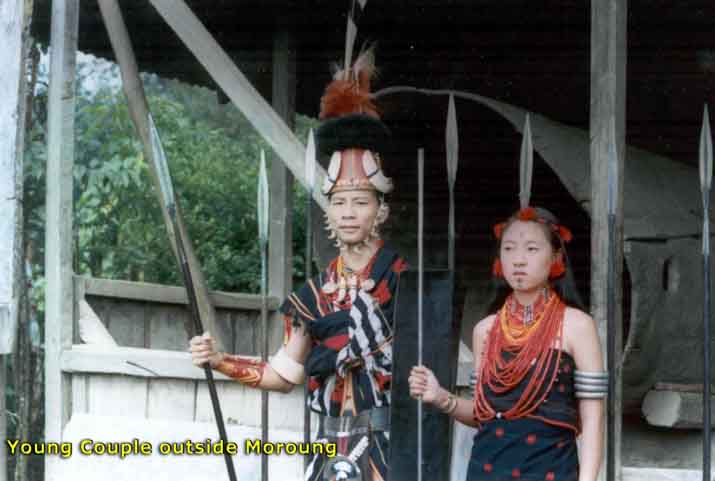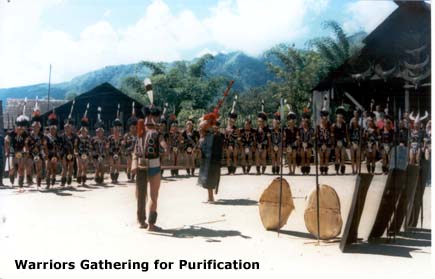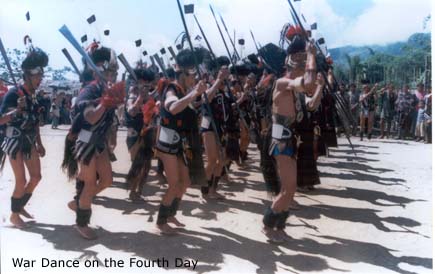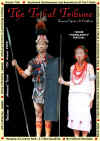Tikhir "TSONGLAKNYI" Festival
The word "Tikhir" means "Dew People", meaning they were the first settlers of the place as they brush up the dewdrops.
The Tikhirs have their first place of organized settlement at a place called "TAIMIPHU" which is located between the duo rivers of Zingki and Yayi in Shamator Sub-Division. This transition and evolution is dated to sometime around 12th and 13th centuries. With the increase in household and population at Taimiphu, the Village separated and began establishing more number of Villages (analogous with other Naga tribes). Some of the important and early Villages were TUKHIAKIUPONG, POWONG (having 999 houses before dispersing again), WONGPHONG presently known as Waphur, etc. This process of fragmentation went on for centuries and all together managed in establishing a good number of Villages. Presently, the Tikhir tribe has within its jurisdiction 42 Villages, Five Government Administrative Units with a population of around 52000 people. The Tikhirs originally were known as TUKHIAUU, however after that the British ascendancy and subsequent annexation of the Naga Hill, the British’s altered the nomenclature TUKHIAUU to TIKHIR. Since then it is been used as the official name of the Tribe. The Tikhirs are known and addressed by other Naga Tribes differently, the Sangtams "Tikhere", the Changs "Thkhupu", the Khimnungan "Chitlihie", the imchungers "Tukhiru" respectively. The Semas (Sumi) called the TIkhirs as 'Tukhemi" (recorded history and map representation In J.H.Hutton's "The Sema Nagas").
The Tikhir issue involves tears, blood and hundreds of innocent Tikhir live sacrificed at the alter of those so called brotherly and sisterly tribes thinking that Tikhirs would surrender their territory, culture, history and most of all her unique Identity. However, instead of weakening, these acts of discrimination, violence, mayhem and carnage have strengthened the Tikhirs more strong and resolute to fight for the rights till the end. Only in the 1980’s, an organized common platform was constituted to protect and preserve the common interest of the Tribe. Today it is spearheaded by the Tikhir Tribal Council/Hoho (TTC), the Tikhir Students' Union (TSU), the apex students body, the Tikhir Baptist Piti Atukhianti (TBPA), the religious wing and the Tikhir Women Hoho, the Women wing. These organizations vehemently opposed the evil moves of the Yimchunaers and dethroned the alien domination, for by nature the Tikhirs are fiercely independent minded people. The Tikhirs have restored once again the status quo as before. The Tikhirs are recognized as a unique and separate Tribe with their own distinct Culture. Tradition, Territory, History and Independent Identity but are denied political or official Recognition of reasons unfounded. The existence and continuity of Tikhirs as a distinct Tribe is unquestionable as history records H all. It is high time the Government of Nagaland also accept the irreversible and inevitable truth that no amount of negotiation, persuasion, force-brute or even violence will yield the Tikhirs to succumb and give up Its rightful demand for Official or Political Recognition as well of the Tikhir Tribe. Praying for Justice to be done to the Tikhirs without wasting further time, "The earlier the better". "Tsonglaknyi" the main Tikhir Festival is observed from 9th - 12lh Oct. every year. The word 'tsonglaknyi' is made up of two words: Tseng7means Shield and 'lak' means sanctification. Tsonglak Nye basically is a festival of the sanctification of Shield. It also means sanctification of the weapons along with their wealth and valuable assets, as well as the purification of the men folk before going out for head hunting (earlier days). In short, it is a festival of purification. This festival is one of the most important among the Tikhir festivals celebrated, stretching for four days.
Day one (1): The announcement/information for the festival is made known every year by the Village headman to the public three days in advance. Once it is made known, everyone young and old alike come together at the Morung relating tales of their adventure and heroic activities, sing folk songs, dancing and merry-making. The knowledge and love of one's culture patriotism and responsibility is inculcated to one and all, especially the young hearts. Morung was an institution of learning in the earlier days. Day Two (2): The Morung is always occupied throughout the festival. The activities at the marling continue, relating tales of adventures and heroism, singing folk songs, dancing and merry-making. Each khel (Cluster of houses under one morung) of the Village visits each other dedicating folk songs and dances to each other. Everyone joins the celebration in joy for the successful accomplishment throughout the year. The festival Is spearheaded by the men folk. Day Three (3): In the evening, when the dances and visiting khels are completed, once again everyone gathers at the morung. Around five or seven warriors with full Traditional attires are chosen for making Bamboo Cups. The making of the cups has its own special significance. They have to make the cups as a tradition, with the best Bamboo. They climb up the Bamboo and pull it down from the top most lip. If it breaks, they go for the other one, because they consider it as a bad sign. Three persons cut out the cups in a single stroke each with their dao. After cutting, the mark is scrutinized. If (here is a clean cut it is taken as a positive sign, which they believe in the coming year that they will be victorious and prosperous. Prom this three cups, they bring water from the source of a rivulet (cleaned and marked earlier) and kept securely tied to the post of the morung to be used on the fourth morning. Day Four (4): In the early morning all the men folk gathers their respective weapons at the morung, particularly war shields, spears, daos, bow & arrows. They line them in a row to be sanctified by the Village Priest (oldest man).
The cock's intestine and heart are taken out and placed on an arrow, which is pierced on a particular tree where they usually hang rival's head. While doing this, the priest chants to let their rival spirit's come and eat it. Then comes the sanctification of the weapons. The remaining parts of the internal organ are crushed into pieces; mix it with rice bear and ginger. The priest chants and throws these on the weapons, which are lined up before him. If any of the pieces get stuck on any of the weapons (particular part), it is taken that the very owner will bring rival head or hunt an animal before long. The blood of the cock is collected in a cone shaped banana leaf. All the male members are made to dip their right finger in the blood, so as to make them bold and courageous while facing the enemy. The water brought from the bamboo cups then washes the dipped finger. This is done so as not to let the evil befall them. The cock is cooked and cut Into small pieces and distributed to all men folk. This is not for eating. The person upon receiving it again makes it into smaller pieces and throws it behind their seat. This is to let the enemy's spirit come and eat it and be their victim. All the ritualistic at the morung being completed, the priest gives out a victory call which Is answered by the victory shout of the men folk. This victory shout signifies (the successful achievement throughout the year as well as) their preparedness for the coming year. All the men folk then disperse to their respective home kill a cock and sanctify their wealth and valuable assets by sprinkling the blood along with the internal organs. The flesh is cooked and ate along with their friends. The females are restricted to eat this particular chicken. For them special meat is arranged which they eat after the men has completed the chicken.
The festival apart from its unique ritualistic art is also a time, when great feast is laid out for all. It is a time when both young and old, poor and rich join together in celebration .The rich and well-do families invites the poor for lunch and give them gifts there by making merry together. The prospective marriageable couples are made known during this time. It is believed that the soul of the dead lives on with the family even after their dead, this festival marks the final departure of the dead from the living. It is also a time for reconciliation and also a time to retrospect and renew oneself. The elders are given due respect.
The festival is celebrated in much fun fare, inviting friends from other walks of life too. Large slices of pork are distributed to friends and well wishers especially to person from other tribes. The festival is celebrated in the best way possible, a moment which is remembered for a long lime. The festival being completed, the people are once again back in their respective activities, but with better preparedness and renewed spirits to achieve greater goals in the coming seasons. |
Photographs : By the Author
References :
- Burma Census Report 1911 – Prof. C. Smith.
- The Sema Nagas – J.H Huttoh
- Nagaland untold story – S.C Dev.
- Political evolution of Nagaland – Dr. Chandrlka Singh
- The Patkoi Nagas – Maj. Gen S.C Sardeshpand
- Census Record of India (since 1961}
- Nagaland District Gazetter – B.B Gosh
- Who is Who (1969) – Govt. of Nagaland










